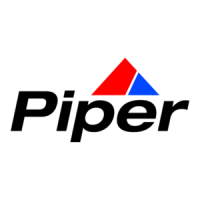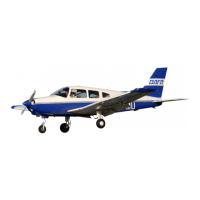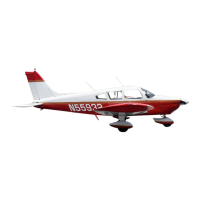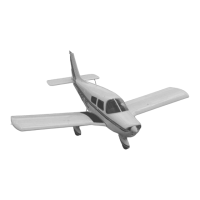PIPER AIRCRAFT, INC.
PA-28-161, WARRIOR III
MAINTENANCE MANUAL
PAGE 1
Nov 30/06
5E13
78-00-00
GENERAL
100 Hour Inspection (See Figure 1.)
WARNING: A VERY THOROUGH INSPECTION OF THE ENTIRE EXHAUST SYSTEM, INCLUDING
EXHAUST HEATER MUFF ASSEMBLY, CROSSOVER TUBES, MUFFLER AND MUFFLER
BAFFLES, STACKS AND ALL EXHAUST CONNECTIONS AND WELDS MUST BE
ACCOMPLISHED AT EACH 100 HOUR INSPECTION.
NOTE: See the latest revision of AC 43.13-1 for additional information on inspecting exhaust systems
and components.
The possibility of exhaust system failure increases with use. Check the system even more carefully as
the number of hours increase; for example an inspection at the 700 hour period would be more critical
than one in the 100 hour period. The system should also be checked carefully before winter operation
when cabin heat will be used.
NO
TE: Piper recommends PA-28 airplanes be fitted with a new muffler at or near 1000 hours
time-in-service.
CA
UTION: WHEN REMOVING OR INSTALLING COUPLING CLAMPS, SLIDE CLAMP OVER END
OF PIPE BEFORE ASSEMBLY. EXCESSIVE SPREADING CAN LEAD TO PREMATURE
FAILURE OF CLAMP.
NOTE: When installing an exhaust clamp having an alignment pin be certain that the pin engages the
mating holes in exhaust pipe and muffler to prevent separation of components.
A. Removal of the tail pipe and stacks are required for inspection of the muffler baffles.
B. Remove or loosen all exhaust shields, cabin heat shroud, heat blankets, etc., as required to permit
inspection of the complete system.
C. Perform the necessary cleaning operations and inspect all external surfaces for dents, cracks and
missing parts.
D. Pay particular attention to welds, clamps, supports and support attachment lugs, slip joints, stack
flanges and gaskets.
E. Inspect internal baffles or diffusers. Any cracks, warpage or severe oxidation are cause for
replacement of muffler or tail pipe assembly.
F. If any component is inaccessible for a thorough visual inspection, accomplish one of the following:
(1) Perform a submerged pressure check of the muffler and exhaust stack at 2 psi air pressure.
(2) Conduct a ground test using a carbon monoxide indicator by heading the airplane into the
wind, warming the engine on the ground, advancing the throttle to full static RPM with cabin
heat valves open, and taking readings of the heated airstream inside the cabin at each outlet.
Appropriate sampling procedures applicable to the particular indicator must be followed. If
carbon monoxide concentration exceeds .005 percent or if a dangerous reading is obtained on
an indicator not calibrated in percentages, the muffler must be replaced.
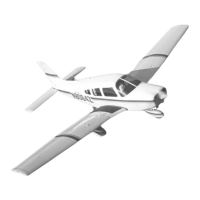
